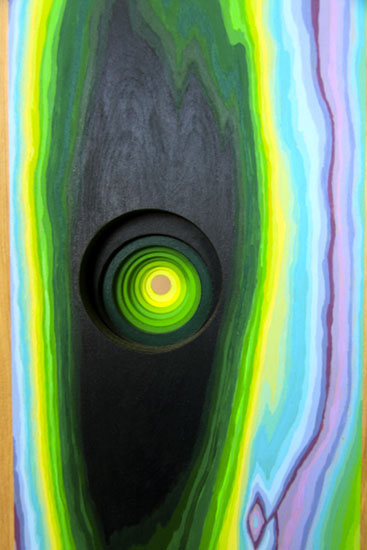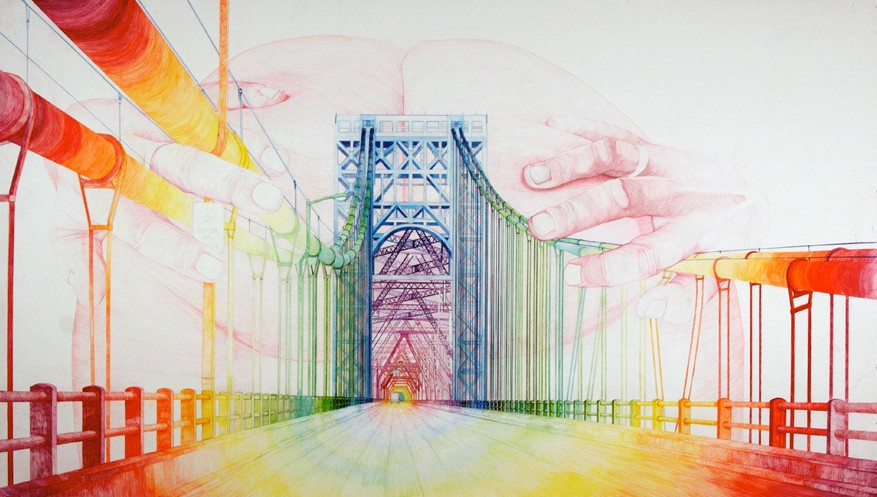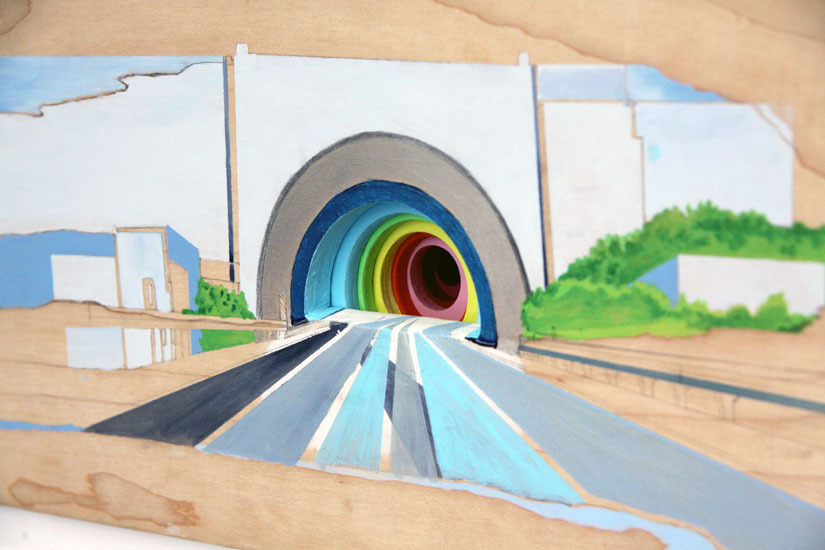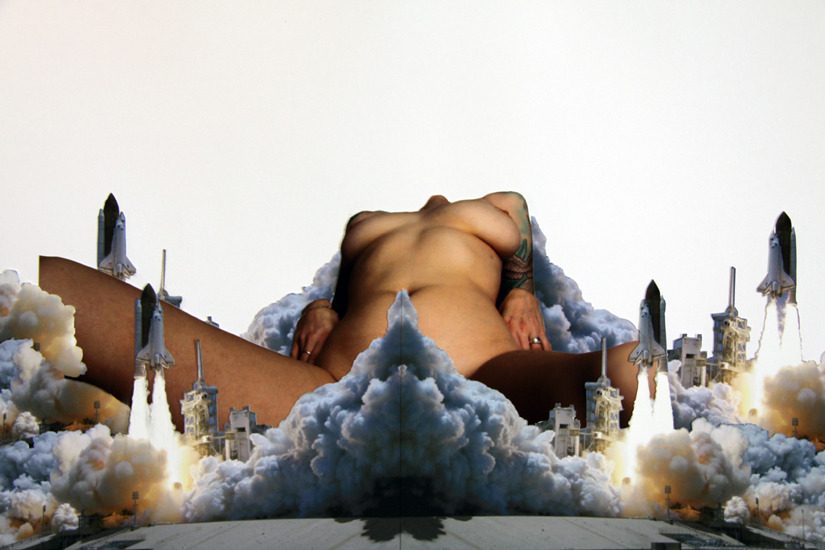Paintings by Suzanne Wright + A Vital Collapse in the Meaning of Holes by Katie Brewer Ball
|
A VITAL COLLAPSE IN THE MEANING OF HOLES Getting lost is simultaneously thrilling and terrifying. New paths open while others are lost as the landscape of the journey changes. Holes are paths that carry us through an object or into the depths of a mass. Traditionally they signify passivity, lack, and danger. Suzanne Wright’s holes series plays on such expectations and uses them to create an opening of space—stages available for action. Her collages, paintings, and color-pencil drawings of divine glory holes and cosmic portals play on the directions we expect holes to take. The holes that flow through her work pull us into the plane of the canvas and sometimes through, drawing the viewer almost magnetically like Alice down the rabbit hole. They propel us away from the place we find ourselves and yet this pull is not unidirectional. The holes possess a wealth of knowledge, these endowed pussies—rich with technology, mobility, and exploration—are not simply an entry point, but instead they bounce-back sending up clouds of smoke or crashing through a cathedral dome.
If a focus on holes doesn’t immediately give it away, then perhaps the women in various stages of over-powering pleasure might gesture to Wright’s deep historical investment in feminist and queer liberation projects. A member of ACT-UP (AIDS Coalition To Unleash Power) and D.I.V.A. TV (Damned Interfering Video Activists) while studying Sculpture at Cooper Union in the late 1980’s, Wright’s aesthetics and activism are intimately intertwined. Her direct political actions were born out of a shared idea that permeated ACT UP and D.I.V.A TV; that aesthetics, performance, and video were powerful media through which to positively impact the lives of people living with AIDS, combat the misinformation and silence promoted by the Regan administration, and end the AIDS crisis. Wright went on to co-found fierce pussy, a group of queer woman creating direct-action art and performance that prioritized lesbian visibility by literally altering the city streets with posters, stickers, and stencils. Continuing her art practice as a political action, critiquing “man made” structures of architecture and power, her work stages political futures and worlds that might be. More recently, Wright has shown work with Ridykeulous (curated by Nicole Eisenman and A.L. Steiner), as part of Shared Women, a gay feminist art show curated by Eve Fowler, and in various other group and solo shows where she continues to mix pleasure and politics. I first began to spend time with Wright’s work in the spring of 2009 for a special journal issue on the topic “feminist landscapes” I co-edited Julia Steinmetz. I was immediately drawn-in by the immense physical size of her work and the scale of the female bodies that take over the surrounding landscapes, effectively dwarfing factories, telephone poles, and train tracks as in her large-scale color-pencil drawing “Choo Choo” (2004/5), or the industrial architecture swallowing “Rainbow Highway” (2008) which spans 7×13 feet, and “Cockpit” (2009) which is an equally impressive 7×10 feet. These images are ready-made landscapes engaging with the genre traditions of landscape painting, and yet they are also spaces of transition and possibility. Church abbeys and ascending airplanes become cultural images of transit, anticipation, and movement. Her series of holes invites a dialogue on pussy power as she illustrates—with great colored-pencil detail—crotches with absented vaginas that transform into bridges and tunnels. Her images show where sexuality meets the landscape. Merging the scale of the human body with immense industrial markers and architectural feats, Wright puts female sexuality center stage, often overpowering and swallowing the scale of the grand duomos, tunnels, or airplanes into soft fleshy holes, or rather spots where these holes should be, effectively turning out absence and lack. “Untitled (Gay Portal)” (2010) imagines a doorway that, in Wright’s own words, moves “from the known to the unknown.”[i] This image evokes a 1970’s post-psychedelic graphic art in tandem with an early feminist science-fiction book-cover aesthetic reminiscent of Joanna Russ’s The Female Man (1970) or Ursula K. Le Guin’s The Left Hand of Darkness (1969). The portal recalls Harvey Milk’s sexual cityscape of the 70s, full of the utopianism of a nascent gay liberation movement, mixed-in with the potential for anonymous pleasure and human contact, and rife with the fear of not quite knowing what exists at the other end of the tunnel. Bearing no specific title—part of her “portal series” and cousin to her “hole series”—Wright’s gay portal leaves it up to the viewer to decide where this particular outlet will take us, if indeed it takes us anywhere. We might link this opening to the tunnel on U.S. Route 101 with a perfect rainbow around its rim that one sees when driving north over San Francisco’s Golden Gate Bridge. And yet, Wright’s portal is not that material landscape portal. Wright’s “Untitled (Gay Portal)” appears on the surface of a large piece of plywood, alone amidst the outlines of empty and clean industrial buildings and hedges. Working with the grain of the wood, Wright’s image depicts an ambiguous wooden lake that reflects and severs the small building on the left of the tunnel before discretely turning into chromatically continuous clouds and streams that meander out of the frame along the line of the stretched and distorted wooden plywood rings. The horizon lines that organize the plane of the image tell the viewer where to stand and pull the line-of-sight in along the stripes as they form a runway leading to the rainbow portal. More complicated than a simple one-point perspective drawing, this orifice does not set forth a direct trajectory, but instead asks viewers to keep going as they bear right, turning into and through a hole that appears to have no end. [ii] 
Moving from fantasy highway tunnels of the unknown and the female reign over the built environment, Wright’s “Galactic Glory Hole (Green)” makes explicit the connection between cosmic and fleshy bodies. Spelunking through the space of the body—an organic body aesthetically envisioned as the rings and grain of plywood, a smooth crosscut of the epidermis of the tree—the shapes recall the resonance of sound waves or the blurry massaging lights of the aurora borealis. Using Birchwood, a canvas similar to that of “(Untitled) Gay Portal,” two-thirds of the board is left blank, while the rest is painted in detail. Tracing the oblong shapes of the plywood, Wright brings attention to the subtle variations of the stretched rings of the tree from which the wood was pulled and flattened like taffy. A solid dark navy-green lake adorns the center of the rings which range center-out from navy, to valley green, through sky blues, and excited shades of lilac. In the lake is another set of circles descending into the flat plane of the canvas. Revisiting the 1960’s Color Field work of Kenneth Noland, these concentric circles fall into the shape at the center in a whirlpool of greens ranging from dark to light. Although the body envisioned here does not immediately recall a human body, when seen in the context of her other pieces that re-imagine classic porn images with queer and feminist tactics, it is hard not to see “Galactic Glory Hole (Green)”—part meeting place for sexual conduct, part topographic map, and part contour drawing of interstellar space—as encounter of the cosmic and fleshy body. This glory hole of galactic proportions—along with Wright’s other portals, vortices, and vessels—invokes real-life cosmic crevices, “black holes.” Writing about the inversion of both stellar and human bodies, contemporary French philosopher Jean-Luc Nancy argues that the body—at the nexus of the terms god, death and flesh—is so over-determined that it falters under the pressure of signification and withdraws in on itself. [iii] The body is thus a vital collapse of sense, an exhaustion of meaning, a withdrawal of cosmic proportions. If the body is thought to weigh from the outside, with its centuries of dense signification, then in its very collapse it presents an opening that marks a spacious breath of release from the burden of the body in western thought. Wright invokes this body-as-hole—this mass that becomes so dense as to literally transform space-time—through images that push her viewers in-and-through, or up, up, and away. Leaping away from the known ground toward another reality, “Galactic Glory Hole (Green)” makes sense through a withdrawal of the proper figure of sense, the properly legible body. As a glory hole, this galactic body is a space for anonymous sexual conduct and transit. It is a hole that provides both a space for the innovative production of meaning and the staging of desire beyond phallic assumptions. At the end of the road, instead of a money shot, we get depth, and the pull of more road. In “Black Tunnel” Wright gives us the edges of holes repeated and miniaturized invoking the Dadaist clippings of Hannah Hoch. The canvas is black except for the upper left-hand corner, which is just barely a lighter shade of gray, signaling perhaps the near proximity or curve of the tunnel wall. Towards the bottom of the canvas, just right of center, a tunnel appears. Again, concentric circles decreasing in size draw us in and through the hole only this time they are not the smooth lines of wood, but like the cogs of a machine clicking into place, or the dials of an antique lock. Amidst the ridged teeth of the tunnel, a lone figure repeats, co-workers mirroring each other in posture and uniform, an echo in the assembly-line production of bodies made for their labor power. Or perhaps this doubling appears not in the reality of the tunnel but instead in the mind of the traveler lost in the areality—both the area and suspended reality—of the hole. [iv] This tunnel feels related to the galactic glory holes that came before, only less magic and more in control of its masses and movement. And yet, in this hole you can’t help but feel already lost in the edges and echoes, turning through the curve of the tunnel, my body turning not once but again, like the circles that appear in front of me. Wrights tunnels, both “Black Tunnel” and “White Tunnel” invoke what Sara Ahmed calls a “queer disorientation.” In contrast to the idea of sexual orientation, where the object of desire or destination is known, a queer disorientation encourages one to veer from known paths, to turn and keep turning instead of following the straight lines set out in front of us. This disorientation that the tunnels evoke is uncanny. The movement is both familiar and radically unfamiliar at once. We know what it is like to move through a tunnel—from experience we trust that there is another end—yet this particular tunnel refuses us the gratification of knowing its end or providing a smooth anonymous passage through the cut-up tubes and past the fragile bodies of our orange-clad observers. Such disorientation opens up a new space by way of not knowing precisely which direction one is traveling, as you turn through repetitions that take one out-of-line. It is this moving off track, off the normative axis of the canvas, that makes Wright’s holes so generative in thinking queer and feminist aesthetics and politics anew. If the promise of the glory hole is that there will be a passage, then to explore this encounter as more then just phallic protrusion, but as a stage for various forms of conduct that move off the straight-and-narrow, demonstrates Wright’s complex understanding of all that bodies and holes can effect as political queer art/work. Re/turning to Wright’s giant female bodies that serve as both intervention in the literal landscape of science and exploration. “Shuttle” is like a Fourth of July firework show in Cape Canaveral. You can almost hear the muffled digital space shuttle countdown and the marching band drumroll. “Shuttle” is at once patriotic and heretical. The inverse of a “black hole,” this is rendering of a “big bang” is a climax of space shuttle lift-offs choreographed in unison from between a woman’s outstretched thighs. This ecstatic “big bang” is the expansion of the universe from a hot and tiny state of matter. The figure behind the clouds of smoke doubling and flowering off the tarmac has her back arched and head fallen in a pleasure-induced release. Instead of seeing an orifice between the legs, this hole is eclipsed by smoke, the billowing exhaust of fire and air being pushed against the ground so hard that it propels up again. In “Shuttle” Wright returns to what it means not to know the body, to posses its likeness, to know its precise meaning, or to enter it. Instead, to touch the limits of the body, to turn into it without knowing where we are going, or what the direction we end up taking means, produces new avenues, apertures, and outlets to meaning itself. Withdrawal into the unknown, met with classic 1970’s porn rethinking and science fiction, enables a rethinking of the question of feminist and queer aesthetic intervention. Wright demonstrates an aesthetic strategy that shows both the visual pleasure of mobility, space exploration, and sexual ecstasy at the same time that she critiques it. Her images sufficiently contain the contradictions of visual pleasure and activism. Getting lost in the polyvalence of holes, exploring them for their perceived absence, Wright envisions the pleasure of seeing sex, of thinking the mass of the female body and it’s ability to move within space, to fall into and on the body itself. The holes series are brightly colored maps of lost worlds, pieced together from the weight of bodies and industry. These constellations are bodies-as-holes and holes-as-bodies that surprise us in the shape and directions they take. The images invoke stages of action, spaces of political and sexual movement that do not involve a straightforward trajectory but insist instead on a queer turning-through and turning-out of body and sexual desire. [i] Suzanne Wright “Artist Statement” http://www.suzannewrightstudio.com[ii] Sections of this essay are pulled from a previous version co-written by Julia Steinmetz and myself in “The Dirt of Feminist Landscapes” for a guest edited issue of the journal Women and Performance: A Journal of Women and Performance, Spring 2011, Issue 1 on the special topic “Feminist Landscapes.” [iii] Nancy, Jean Luc. Corpus (New York: Fordham University Press, 2008), 75
[iv] Nancy, Jean Luc. Corpus (New York: Fordham University Press, 2008), 43
For more on Suzanne Wright and Katie Brewer Ball visit here + here.
IMAGES by Suzanne Wright:Cockpit, drawing, Untitled (Gay Portal), mixed-media Rainbow Highway, drawing Green Galactic Glory Hole, mixed media Four Shuttles, collage |




